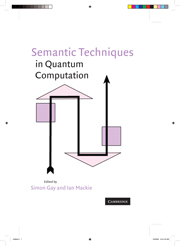Book contents
- Frontmatter
- Contents
- Contributors
- Preface
- 1 No-Cloning in Categorical Quantum Mechanics
- 2 Classical and Quantum Structuralism
- 3 Generalized Proof-Nets for Compact Categories with Biproducts
- 4 Quantum Lambda Calculus
- 5 The Quantum IO Monad
- 6 Abstract Interpretation Techniques for Quantum Computation
- 7 Extended Measurement Calculus
- 8 Predicate Transformer Semantics of Quantum Programs
- 9 The Structure of Partial Isometries
- 10 Temporal Logics for Reasoning about Quantum Systems
- 11 Specification and Verification of Quantum Protocols
- Index
- References
9 - The Structure of Partial Isometries
Published online by Cambridge University Press: 05 July 2014
- Frontmatter
- Contents
- Contributors
- Preface
- 1 No-Cloning in Categorical Quantum Mechanics
- 2 Classical and Quantum Structuralism
- 3 Generalized Proof-Nets for Compact Categories with Biproducts
- 4 Quantum Lambda Calculus
- 5 The Quantum IO Monad
- 6 Abstract Interpretation Techniques for Quantum Computation
- 7 Extended Measurement Calculus
- 8 Predicate Transformer Semantics of Quantum Programs
- 9 The Structure of Partial Isometries
- 10 Temporal Logics for Reasoning about Quantum Systems
- 11 Specification and Verification of Quantum Protocols
- Index
- References
Summary
Abstract
It is well known that the “quantum logic” approach to the foundations of quantum mechanics is based on the subspace ordering of projectors on a Hilbert space. In this paper, we show that this is a special case of an ordering on partial isometries, introduced by Halmos and McLaughlin. Partial isometries have a natural physical interpretation, however, they are notoriously not closed under composition. In order to take a categorical approach, we demonstrate that the Halmos-McLaughlin partial ordering, together with tools from both categorical logic and inverse categories, allows us to form a category of partial isometries.
This category can reasonably be considered a “categorification” of quantum logic – we therefore compare this category with Abramsky and Coecke's “compact closed categories” approach to foundations and with the “monoidal closed categories” view of categorical logic. This comparison illustrates a fundamental incompatibility between these two distinct approaches to the foundations of quantum mechanics.
9.1 Introduction
As early as 1936, von Neumann and Birkhoff proposed treating projectors on Hilbert space as propositions about quantum systems (Birkhoff and von Neumann 1936), by direct analogy with classical order-theoretic approaches to logic. Boolean lattices arise as the Lindenbaum-Tarski algebras of propositional logics, and as the set of all projectors on a Hilbert space also forms an orthocomplemented lattice, the operations meet, join, and complement were analogously interpreted as the logical connectives conjunction, disjunction, and negation.
- Type
- Chapter
- Information
- Semantic Techniques in Quantum Computation , pp. 361 - 388Publisher: Cambridge University PressPrint publication year: 2009
References
- 2
- Cited by



